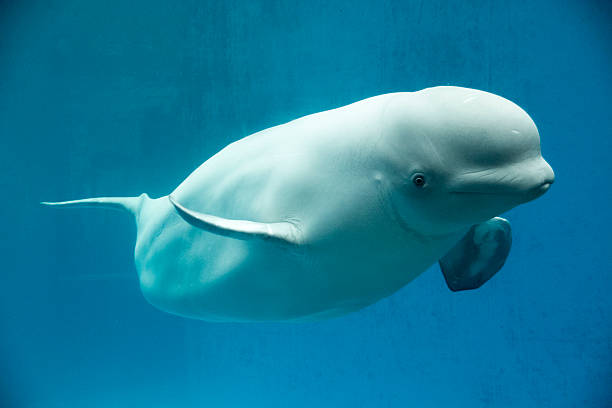ANIMAL: Beluga Whale Delphinapterus leucas Type of Animal: Toothed Whale Habitat: Coastal waters, seas adjacent to coastal waters, coastal bays, inlets, seasonally ice-covered waters, areas near ice floes/icebergs, coastal coves, coastal fjords, coastal canals, deeper offshore waters (can dive as deep as 3,280.84 ft for 25 minutes), cold oceans, open ocean, continental shelves, estuaries, mudflats, large river deltas, rivers, river basins, thrive in salt, brackish, & freshwater Location(s): Circumpolar Arctic & sub-Arctic down to St. Lawrence River of E Canada & waters around NE Russia & NE China. Vagrants have been seen in Irish, Scottish, N Japanese, & Korean waters. Appearance: Stocky white animal, males larger than females, round body, melon-shaped head, broad short flippers, becomes whiter w/ age w/ calves being grayish, no dorsal fin Food/Diet: Octopus, squid, crustaceans, clams, snails, marine worms, fish, mussels, zooplankton Status in Wild: Stable Conservation: Breeding in aquariums & marine parks. Monitoring of wild populations that are more at risk. Lifestyle: Pods range from 10-1,000 animals Additional Info: Called: Male: Bull Female: Cow Young: Calf Group: Pod Weight: Male: 1.65 tons Female: 1.49 tons Young: 600-800 lbs Gestation: 14-15 months Life Span: 30-35 years in captivity, 40-60 years in wild Body Length: Male: 12-16 ft Female: 9.5-13 ft Young: 7 ft Tail Length: Male: 1.8-2 ft Female: 1.3-1.5 ft Main predators are orcas/killer whales, polar bears, & Greenland sharks. While stable & increasing in much of range, threats include water pollution, habitat degradation, harassment, negative interactions w/ fisheries, entanglement in fishing nets, oil/gas exploration, climate change, overfishing, pathogens, mining, & hunting. Females mature at 4 years old & males at 6 years old. Each summer, they shed skin by rubbing against coarse gravel. These animals tend to be very curious & friendly. These animals are very playful & will play w/ random objects they find. Like many other toothed whales, they use echolocation for movement, communication, finding breathing areas, & hunting. Most populations are migratory but some are more sedentary. Fun Fact(s): Due to their many vocalizations, they’re often called Sea Canaries. Also called White Whales & Melonheads. In 1980, singer Raffi made an album & song called Baby Beluga. Captive belugas have been observed to mimic human speech. Due to vertebrae not being fused together, they can turn heads up, dowm, & side-to-side. Word “Beluga” derives from Russian word Bielo meaning white. Can change shape of melon-shaped head by blowing air around sinuses. In Finding Dory, character Bailey is a Beluga Whale.
